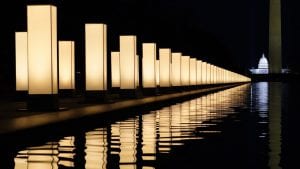 The Lincoln Memorial is usually bustling with energy and activity on the eve of a presidential inauguration, when it takes center stage for concerts, crowds, and celebrations.1 This year was different. The Biden Inaugural Committee struck a deeply somber tone in the midst of the pandemic, holding what was the first national memorial service for those who have died from COVID-19. That day, the United States surpassed 400,000 deaths from the virus since the first case was reported nearly one year ago.2
The Lincoln Memorial is usually bustling with energy and activity on the eve of a presidential inauguration, when it takes center stage for concerts, crowds, and celebrations.1 This year was different. The Biden Inaugural Committee struck a deeply somber tone in the midst of the pandemic, holding what was the first national memorial service for those who have died from COVID-19. That day, the United States surpassed 400,000 deaths from the virus since the first case was reported nearly one year ago.2
Until that moment, there had been no national recognition of the true cost of the pandemic. As BuzzFeed News reporter Amber Jamieson noted months prior, “Despite the enormous number of deaths—and the impact felt deeply by survivors of the virus, loved ones of the dead, and those suffering the enormous economic fallout—there has been no official national mourning. No minute of silence, no plans for a memorial to be erected in their honor, no collective grieving.”3 People stayed home to stay away from each other. They were barred from visiting loved ones in hospitals. Funerals were restricted to immediate family members only. Then-Vice President-elect Kamala Harris acknowledged this private pain that so many have felt. “For many months, we have grieved by ourselves,” she said. “Tonight, we grieve and begin healing together. Though we may be physically separated, we the American people are united in spirit.”4
WATCH: The COVID-19 Memorial Service, from ABC News
As the sun set, 400 rectangular lights—spanning the entire length of the Reflecting Pool on both sides—were simultaneously illuminated, with each light representing 1,000 lives lost to the virus.5 They stretched toward the World War II Memorial, which prominently features over 4,000 gold stars in memory of the 400,000 Americans killed in that conflict. At that moment, landmarks across the country were lit in solidarity, and a nurse from Michigan and a gospel singer performed “Amazing Grace” and “Hallelujah” as part of the service.6
With the national spotlight on his inauguration, then-President-elect Joe Biden planned this memorial as his first event in our nation’s capital. He stressed unity in his remarks, underscoring his desire to move the country past the pandemic by first paying tribute to the lives that have been lost. “To heal, we must remember. It’s hard sometimes to remember. But that’s how we heal,” he said. “It’s important to do that as a nation. That’s why we’re here today.”7
Discussion Questions
- Look at this photo gallery of the Inaugural COVID-19 Memorial. How do the images make you feel? What stands out to you?
- How is this memorial similar to or different from any other memorial you have seen?
- How does this memorial express or shape the public feelings of the pandemic?
- What can the memorial tell us about the Biden administration’s messaging, vision, or priorities in addressing the COVID-19 pandemic?
As always, we encourage you to join the discussion with your comments or questions below!
Sources
Featured Image Credit: Alex Brandon/AP
[1] Time: https://time.com/4640346/donald-trump-lincoln-memorial/
[2] CNN: https://www.cnn.com/2021/01/19/health/us-coronavirus-tuesday/index.html
[3] BuzzFeed News: https://www.buzzfeednews.com/article/amberjamieson/coronavirus-200000-mourning-the-dead
[4] NPR: https://www.npr.org/sections/biden-transition-updates/2021/01/19/958548751/we-must-remember-biden-harris-memorialize-covid-19-victims
[5] New York Times: https://www.nytimes.com/2021/01/19/world/joe-biden-coronavirus-us-deaths.html
[6] Billboard: https://www.billboard.com/articles/news/politics/9513523/yolanda-adams-hallelujah-joe-biden-covid-19-memorial/
[7] New York Times: https://www.nytimes.com/2021/01/19/world/joe-biden-coronavirus-us-deaths.html
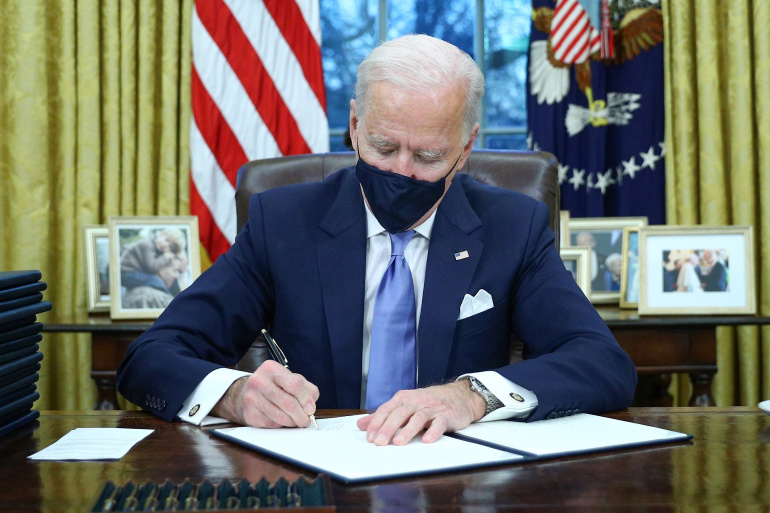
 The fallout continues to mount from the January 6 attack on the Capitol. In previous blog posts, we offered a
The fallout continues to mount from the January 6 attack on the Capitol. In previous blog posts, we offered a 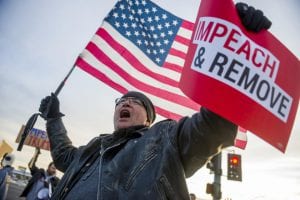 The events at the Capitol on January 6 are forcing voters and elected officials to face some challenging questions. In a
The events at the Capitol on January 6 are forcing voters and elected officials to face some challenging questions. In a 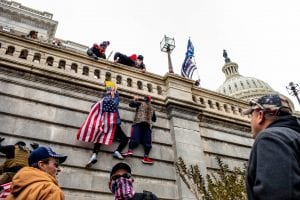 On January 6, 2021, Congress convened to certify the Electoral College results of the 2020 presidential election and to affirm the victory of President-elect Joe Biden. Although there has been no evidence of voter fraud, a group of Republican legislators planned to object to the certification process, saying they wanted Congress first to create an electoral commission to investigate the results in certain states. This objection would not stop the certification, only delay it.1
On January 6, 2021, Congress convened to certify the Electoral College results of the 2020 presidential election and to affirm the victory of President-elect Joe Biden. Although there has been no evidence of voter fraud, a group of Republican legislators planned to object to the certification process, saying they wanted Congress first to create an electoral commission to investigate the results in certain states. This objection would not stop the certification, only delay it.1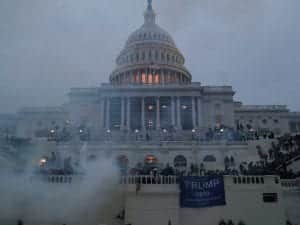
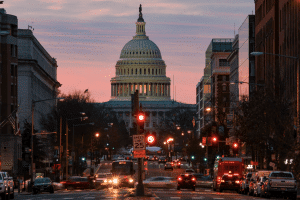 The 117th Congress was sworn in on January 3, 2021.1 This is the most diverse Congress ever,2 with a record number of women and LGBTQ members, a slim Democratic majority in the House, and a Senate that is still up for grabs due to runoff elections taking place this week in Georgia.3
The 117th Congress was sworn in on January 3, 2021.1 This is the most diverse Congress ever,2 with a record number of women and LGBTQ members, a slim Democratic majority in the House, and a Senate that is still up for grabs due to runoff elections taking place this week in Georgia.3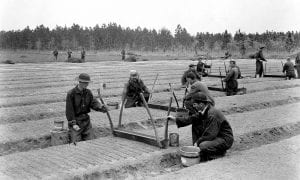
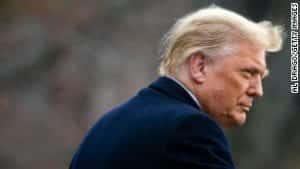 As journalists, historians, and political commentators reflect on the administration of outgoing President Donald Trump, one word keeps coming up: norms. To his critics, this is cause for concern. But President Trump’s supporters sometimes see his norm-breaking actions as efforts to change the political culture of Washington. Here, we will offer definitions and examples of political norms, rules, and traditions that President Trump has broken, consider the possible consequences, and ask what, if anything, should be done to reaffirm those norms.
As journalists, historians, and political commentators reflect on the administration of outgoing President Donald Trump, one word keeps coming up: norms. To his critics, this is cause for concern. But President Trump’s supporters sometimes see his norm-breaking actions as efforts to change the political culture of Washington. Here, we will offer definitions and examples of political norms, rules, and traditions that President Trump has broken, consider the possible consequences, and ask what, if anything, should be done to reaffirm those norms.
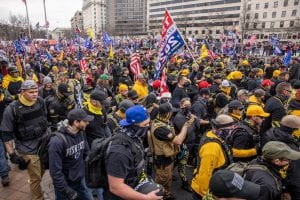 Most Republicans in the House of Representatives signed letters of support for a lawsuit brought by the state of Texas, although Senate Republicans did not.11 Some Trump supporters have latched on to the president’s defiance as well. They note that in the 2000 presidential election, Vice President Al Gore waited to concede to Governor George W. Bush until December 13, the day after the Supreme Court ordered a stop to the recount in Florida. On December 12, groups supporting President Trump, including the male chauvinist organization Proud Boys, clashed with protesters in Washington, D.C.; at least four people were stabbed (the political allegiances of both the stabbing suspect and the victims is presently unknown).12 Several Black churches were also targeted and vandalized.13
Most Republicans in the House of Representatives signed letters of support for a lawsuit brought by the state of Texas, although Senate Republicans did not.11 Some Trump supporters have latched on to the president’s defiance as well. They note that in the 2000 presidential election, Vice President Al Gore waited to concede to Governor George W. Bush until December 13, the day after the Supreme Court ordered a stop to the recount in Florida. On December 12, groups supporting President Trump, including the male chauvinist organization Proud Boys, clashed with protesters in Washington, D.C.; at least four people were stabbed (the political allegiances of both the stabbing suspect and the victims is presently unknown).12 Several Black churches were also targeted and vandalized.13






